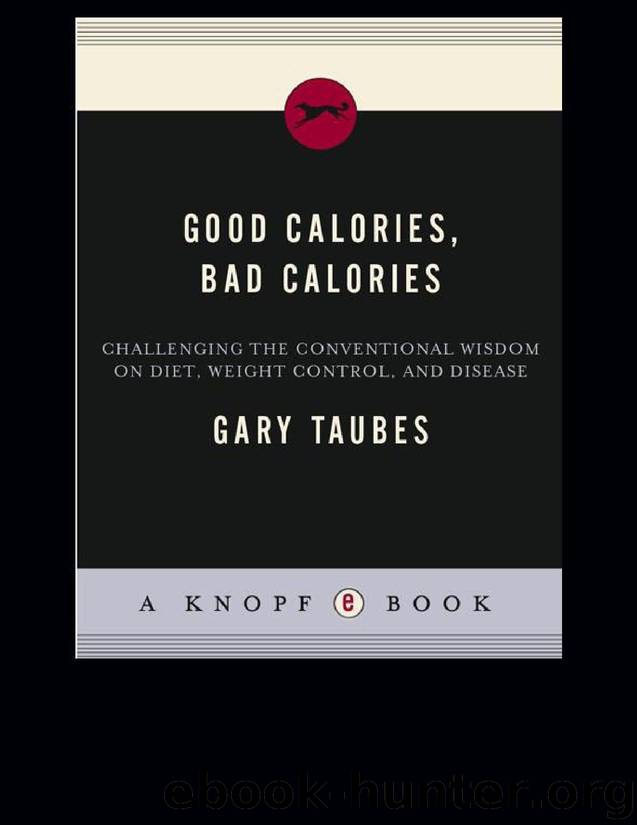Good Calories, Bad Calories by Gary Taubes

Author:Gary Taubes
Language: pl
Format: mobi, epub
Published: 2011-01-10T10:12:25.546000+00:00
For the past quarter century, public-health authorities and obesity researchers have insisted that it is dietary fat, not carbohydrates, that fattens most effectively and causes obesity. This is why low-fat, low-calorie diets are recommended for weight loss as wel as prevention of heart disease. This notion is based on four pieces of evidence, al of which are easily chal enged.
The one that has been most influential is the association between heart disease, obesity, and diabetes. If heart disease is caused by high-fat diets, as is commonly believed, then so are obesity and diabetes, since these diseases appear together in both individuals and populations. But there is no evidence linking obesity to dietary-fat consumption, neither between populations nor in the same populations.*91 And, of course, if dietary fat is not responsible for heart disease, then it’s unlikely that it plays a role in obesity and diabetes.
Second, laboratory rats wil become obese on a high-fat diet. This is the evidence that convinced George Bray that excessive dietary fat would cause obesity in humans, too, and Bray has been among the most influential obesity authorities and the foremost proponent of this dietary-fat/obesity hypothesis. According to Bray, the rats used in his laboratory experiments would grow reliably obese on high-fat diets. “I could feed them any kind of composition of carbohydrates I want,” Bray said, “and in the presence of low fat, they don’t get fat. If I raised the fat content, particularly saturated fat, in susceptible [my italics] strains I would get obesity regularly.”
But some strains of rats, perhaps most of them, wil not grow obese on high-fat diets, and even those that do wil grow fatter on a high-fat, high-carbohydrate diet than a high-fat, low-carbohydrate diet. Moreover, to induce obesity even in susceptible rodents, the percentage of fat in the diet has to be greater than 30 percent, and usual y closer to 40 or even 60 percent (which stil makes only some strains of rats fat). Though 30 percent sounds like a low-fat or moderate-fat diet for humans, it’s far greater than anything rats would normal y consume, either in the wild or in the laboratory. It’s what researchers wil cal a pharmaceutical dosage of fat. Rat chow is typical y 2–6 percent fat calories. Rats wil also fatten when fed large amounts of carbohydrates in the form of sugar. Moreover, other animals fatten on carbohydrates, including pigs—whose digestive apparatus is most like that of humans among experimental animals—cattle, and monkeys.
In the 1970s, Anthony Sclafani of Brooklyn Col ege demonstrated that rats get “super obese” if al owed to freely consume a selection of foods from the local supermarket. This made their eating habits and subsequent obesity seem particularly like ours in character. But, as Sclafani explained, his rats fattened preferential y on sweetened condensed milk, chocolate-chip cookies, and bananas. Among the foods they didn’t eat to excess were cheese, pastrami, and peanut butter—the items that were high in fat and low in carbohydrates.
The third supporting leg of the hypothesis that
Download
This site does not store any files on its server. We only index and link to content provided by other sites. Please contact the content providers to delete copyright contents if any and email us, we'll remove relevant links or contents immediately.
When Breath Becomes Air by Paul Kalanithi(7256)
Why We Sleep: Unlocking the Power of Sleep and Dreams by Matthew Walker(5637)
Paper Towns by Green John(4165)
The Immortal Life of Henrietta Lacks by Rebecca Skloot(3821)
The Sports Rules Book by Human Kinetics(3582)
Dynamic Alignment Through Imagery by Eric Franklin(3482)
ACSM's Complete Guide to Fitness & Health by ACSM(3460)
Kaplan MCAT Organic Chemistry Review: Created for MCAT 2015 (Kaplan Test Prep) by Kaplan(3419)
Introduction to Kinesiology by Shirl J. Hoffman(3297)
Livewired by David Eagleman(3116)
The River of Consciousness by Oliver Sacks(2989)
Alchemy and Alchemists by C. J. S. Thompson(2909)
The Death of the Heart by Elizabeth Bowen(2896)
Descartes' Error by Antonio Damasio(2728)
Bad Pharma by Ben Goldacre(2724)
The Gene: An Intimate History by Siddhartha Mukherjee(2488)
Kaplan MCAT Behavioral Sciences Review: Created for MCAT 2015 (Kaplan Test Prep) by Kaplan(2486)
The Fate of Rome: Climate, Disease, and the End of an Empire (The Princeton History of the Ancient World) by Kyle Harper(2430)
The Emperor of All Maladies: A Biography of Cancer by Siddhartha Mukherjee(2427)
